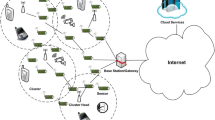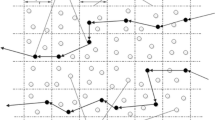Abstract
In the wireless sensor networks (WSNs), energy consumption is one of the significant factors. Most of the energy in a WSN is consumed by communication between nodes. To minimize energy consumption, routing protocols can be merged with data aggregation techniques. The geographic adaptive fidelity (GAF) protocol is one of the prominent geographic routing protocols which is proposed in order to reduce energy consumption in WSNs. Moreover, compressive sensing (CS) theory presented as an alternative method for data gathering in WSNs, known as compressive data gathering (CDG). CDG reduces the cost of communications and balances the energy load in the network without imposing heavy computation or transmission overhead. With CDG, instead of receiving all readings from the sensors, the sink may receive few weighted sums of all the readings by which original data can be recovered by the sink. In this paper, we propose a GAF-based routing protocol based on CDG technique named fuzzy GAF based on CDG (FGAF-CDG). In this work, we partition the sensors area into virtual hexagonal grid cells firstly and then we lay the cells according to their geographic locations. In each sampling round, cluster head (CH) sensor in each grid cell is selected based on a fuzzy logic-based algorithm. Then, CH readings will be forwarded to the sink in a multi-hop path based on a fuzzy-based routing algorithm in the CDG form. Simulation results show that the proposed method results in superior efficiency as compared to other competitive GAF-based methods. For example, the proposed model offers about 50% reduction in energy consumption as compared to FTGAF-HEX method depending on the dimensions of the sensors area.


























Similar content being viewed by others
Explore related subjects
Discover the latest articles, news and stories from top researchers in related subjects.References
Akyildiz IF, Su W, Sankarasubramaniam Y, Cayirci E (2002) Wireless sensor networks: a survey. Comput Netw 38(14):393–422
Bajwa W, Haupt A, Sayeed A, Nowak R (2006) Compressive wireless sensing. In: Proceedings of 5th international conference on information processing in sensor networks (IPSN), Nashville, Tennessee, USA, 19–21 Apr 2006, pp 134–142
Bandyopadhyay S, Coyle EJ (2003) An energy efficient hierarchical clustering algorithm for wireless sensor networks. Proc IEEE INFOCOM 2003:1713–1723
Bhattacharyya D, Kim TH, Pal S (2010) A comparative study of wireless sensor networks and their routing protocols. Sensors 10(12):10506–10523
Bhuiyan M, Wang G, Vasilakos A (2015) Local area prediction-based mobile target tracking in wireless sensor networks. IEEE Trans Comput 64(7):1968–1982
Candes E, Wakin M (2008) An introduction to compressive sampling. IEEE Signal Process Mag 25(2):21–30
Candes E, Romberg J, Tao T (2006) Robust uncertainty principles: exact signal reconstruction from highly incomplete frequency information. IEEE Trans Inf Theory 52(2):489–509
Cao G, Yu F, Zhang B (2011) Improving network lifetime for wireless sensor network using compressive sensing. In: Proc. IEEE 13th international conference on high performance computing and communications (HPCC), Banff, Canada, 2–4 Apr 2011, pp 448–454
Chiang SY, Wang JL (2008) Routing analysis using fuzzy logic systems in wireless sensor networks. In: Proc. international conference on knowledge-based and intelligent information and engineering systems, Zagreb, Croatia, 3–5 Sep 2008, pp 966–973
Cuevas-Martinez JC, Yuste-Delgado AJ, Triviño-Cabrera A (2017) Cluster head enhanced election Type-2 fuzzy algorithm for wireless sensor networks. IEEE Commun Lett 21(9):2069–2072
Donoho DL (2006) Compressed sensing. IEEE Trans Inf Theory 52(4):1289–1306
Ebrahimi D, Assi C (2014) A distributed method for compressive data gathering in wireless sensor networks. IEEE Commun Lett 18(4):624–627
Ebrahimi D, Assi C (2016) On the interaction between scheduling and compressive data gathering in wireless sensor networks. IEEE Trans Wireless Commun 15(4):2845–2858
Erman A, Dilo A, Havinga P (2012) A virtual infrastructure based on honeycomb tessellation for data dissemination in multi-sink mobile wireless sensor networks. EURASIP J on Wireless Commun Netw 1:1–17
Estrin D, Culler D, Pister K, Sukhatme G (2002) Connecting the physical world with pervasive networks. IEEE Pervasive Comput 1(1):59–69
Grover J, Shikha, Sharma M (2014) Optimized GAF in wireless sensor network. In: Proc. 3rd international conference on reliability, Infocom Technologies and Optimization (ICRITO) (trends and future directions). https://doi.org/10.1109/icrito.2014.7014686
Haupt J, Bajwa W, Rabbat M, Nowak R (2008) Compressed sensing for networked data. IEEE Signal Process Mag 25(2):92–101
Heinzelman W, Chandrakasan A, Balakrishnan H (2002) An application-specific protocol architecture for wireless microsensor networks. IEEE Trans Wireless Commun 1(4):660–670
Inagaki T, Ishihara S (2009) HGAF: a power saving scheme for wireless sensor networks. Inform Process Soc Jpn J 50(10):2520–2531
Ji S, Beyah R, Cai Z (2014) Snapshot and continuous data collection in probabilistic wireless sensor networks. IEEE Trans Mob Comput 13(3):626–637
Lan KC, Wei MZ (2017) A compressibility-based clustering algorithm for hierarchical compressive data gathering. IEEE Sens J 17(8):2550–2562
Lee JS, Cheng WL (2012) Fuzzy-logic-based clustering approach for wireless sensor networks using energy predication. IEEE Sens J 12(9):2891–2897
Liu G, Wen W (2010) A improved GAF clustering algorithm for three-dimensional underwater acoustic networks. In: Proc. international symposium on computer communication control and automation (3CA). https://doi.org/10.1109/3ca.2010.5533743
Liu RP, Rogers G, Zhou S (2006) Honeycomb architecture for energy conservation in wireless sensor networks. In: Proc. ieee global telecommunications conference (GLOBECOM). https://doi.org/10.1109/glocom.2006.972
Luo C, Wu F, Sun J, Chen CW (2009) Compressive data gathering for large-scale wireless sensor networks. In: Proc. 15th annual international conference on mobile computing and networking, Beijing, China, 20–25 Sep 2009, pp 145–156
Luo C, Wu F, Sun J, Chen CW (2010) Efficient measurement generation and pervasive sparsity for compressive data gathering. IEEE Trans Wireless Commun 9(12):3728–3738
Nayak P, Anurag D (2015) A fuzzy logic based clustering algorithm for WSN to extend the network lifetime. IEEE Sens J 16(1):137–144
Nayak P, Vathasavai B (2017) Energy efficient clustering algorithm for multi-hop wireless sensor network using type-2 fuzzy logic. IEEE Sens J 17(14):4492–4499
Neamatollahi P, Naghibzadeh M, Abrishami S (2017) Fuzzy-based clustering-task scheduling for lifetime enhancement in wireless sensor networks. IEEE Sensor J 17(20):6837–6844
Nejad AE, Arbabi M, Romouzi M (2014) A survey on fuzzy based clustering routing protocols in wireless sensor networks: a new viewpoint. Int J Mechatronics Electr Comput Technol 4(10):1186–1199
Ni Q, Pan Q, Du H, Cao C, Zhai Y (2017) A novel cluster head selection algorithm based on fuzzy clustering and particle swarm optimization. IEEE/ACM Trans Comput Biol Bioinf 14(1):76–84
Pantazis NA, Vergados DD (2007) A survey on power control issues in wireless sensor networks. IEEE Commun Surv Tutor 9(4):86–107
Qiao J, Zhang X (2018) Compressive data gathering based on even clustering for wireless sensor networks. IEEE Access 6:24391–24410
Shah B, Iqbal F, Abbas A, Kim KI (2015) Fuzzy logic-based guaranteed lifetime protocol for real-time wireless sensor networks. Sensors 15(8):20373–20391
Shang F, Liu J (2012) Multi-hop topology control algorithm for wireless sensor networks. J Netw 9(7):1407–1414
Sharieh A, Mohammad Q, Almobaideen W, Sliet A (2008) Hex-Cell: modeling, topological properties and routing algorithm. Eur J Sci Res 22(2):457–468
Soni V, Mallick DJ (2015) A novel scheme to minimize hop count for GAF in wireless sensor networks: two-level GAF. J Comput Netw Commun. https://doi.org/10.1155/2015/527594
Soni V, Mallick DK (2016) An optimal geographic routing protocol based on honeycomb architecture in wireless sensor networks. In: IEEE international conference on electrical, electronics, and optimization techniques (ICEEOT). https://doi.org/10.1109/iceeot.2016.7755558
Soni V, Mallick DK (2017) FTGAF-HEX: fuzzy logic based two-level geographic routing protocol in wireless sensor networks. Microsyst Technol 23(8):3443–3455
Soro S, Heinzelman WB (2009) Cluster head selection techniques for coverage preservation in wireless sensor networks. Ad Hoc Netw 7(5):955–972
Vempaty A, Ozdemir O, Agrawal K, Chen H, Varshney PK (2013) Localization in wireless sensor networks: byzantines and mitigation techniques. IEEE Trans Signal Process 61(6):1495–1508
Wang S, Chen Z (2013) LCM: a link-aware clustering mechanism for energy-efficient routing in wireless sensor networks. IEEE Sens J 13(2):728–736
Wu X, Tavildar S, Shakkottai S, Richardson T, Li J, Laroia R, Jovicic A (2013) FlashLinQ: a synchronous distributed scheduler for peer-topeer ad hoc networks. IEEE/ACM Trans Netw 21(4):1215–1228
Xiang L, Luo J, Rosenberg C (2013) Compressed data aggregation: energy-efficient and high-fidelity data collection. IEEE/ACM Trans Netw 21(6):1722–1735
Xie R, Jia X (2014) Transmission-efficient clustering method for wireless sensor networks using compressive sensing. IEEE Trans Parallel Distrib Syst 25(3):806–815
Xiong Z, Liveris A, Cheng S (2004) Distributed source coding for sensor networks. IEEE Signal Process Mag 21(5):80–94
Xu Y, Heidemann J, Estrin D (2001) Geography-informed energy conservation for ad hoc routing. In: Proc. 7th annual international conference on mobile computing and networking (MobiCOM), Rome, Italy, 16–21 July 2001, pp 70–84
Xu E, Ding Z, Dasgupta S (2013) Target tracking and mobile sensor navigation in wireless sensor networks. IEEE Trans Mob Comput 12(1):177–186
Younis O, Fahmy S (2004) HEED: a hybrid, energy-efficient, distributed clustering approach for ad hoc sensor networks. IEEE Trans Mob Comput 3(4):366–379
Younis O, Krunz M, Ramasubramanian S (2006) Node clustering in wireless sensor networks: recent developments and deployment challenges. IEEE Netw 20(3):20–25
Yousef R, Ahmad R, Hassib A (2017) Fuzzy power allocation for opportunistic relay in energy harvesting wireless sensor networks. IEEE Access 5:17165–17176
Youssef M, Youssef A, Younis M (2009) Overlapping multi-hop clustering for wireless sensor networks. IEEE Trans Parallel Distrib Syst 20(12):1844–1856
Zheng H, Xiao S, Wang X, Tian X, Guizani M (2013) Capacity and delay analysis for data gathering with compressive sensing in wireless sensor networks. IEEE Trans Wireless Commun 12(2):917–927
Author information
Authors and Affiliations
Corresponding author
Additional information
Publisher's Note
Springer Nature remains neutral with regard to jurisdictional claims in published maps and institutional affiliations.
Rights and permissions
About this article
Cite this article
Ghaderi, M.R., Tabataba Vakili, V. & Sheikhan, M. FGAF-CDG: fuzzy geographic routing protocol based on compressive data gathering in wireless sensor networks. J Ambient Intell Human Comput 11, 2567–2589 (2020). https://doi.org/10.1007/s12652-019-01314-1
Received:
Accepted:
Published:
Issue Date:
DOI: https://doi.org/10.1007/s12652-019-01314-1




